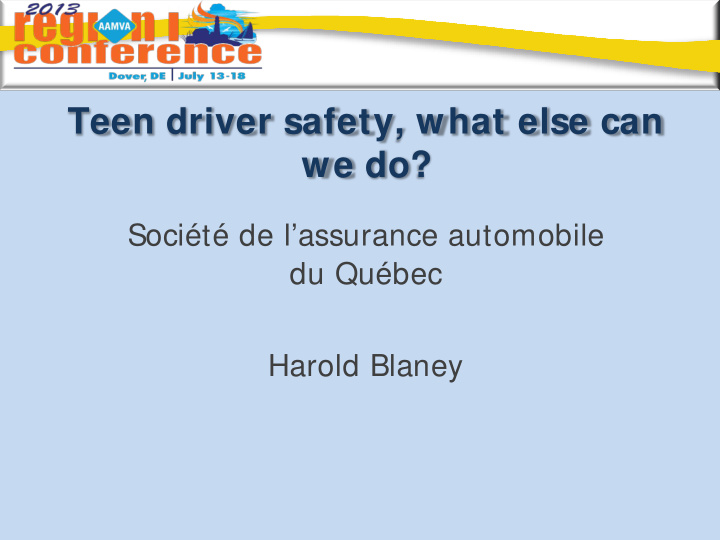



Teen driver safety, what else can we do? Société de l’assurance automobile du Québec Harold Blaney
Presentation Outline • Overrepresentation of young drivers in accidents • Graduated licensing • Road Safety Education Program – Principles and contributions • Ongoing projects • Youth outreach
I n Québec, road accidents, along with suicide, are the main cause of death among young people age 15 to 24 Source: Le bilan démographique du Québec , 2010 Edition, Institut de la statistique du Québec.
I n 2012, young drivers made up only 10% of licence holders, yet they represented 22% of drivers involved in an accident resulting in bodily injuries
Overrepresentation of young drivers in road accidents Proportion of young drivers involved in an accident in 2012 Fatal Accidents Accidents Total accidents with with minor serious injuries injuries 16 to 24 21% 24% 22% 22% 16 to 19 8% 9% 9% 9% 20 to 24 13% 15% 13% 13% Source: 2012 road safety record, SAAQ.
Overrepresentation of young drivers in offences in 2011 Licence holders Total offences Speeding Speeding or Age resulting in (> 45 km/h) driving demerit points recklessly 16 to 24 10% 17% 36% 43% Source Dossier statistique : les infractions et les sanctions reliées à la conduite d’un véhicule routier, 2002-2011 .
Brief history of measures intended to guide the acquisition of experience by young drivers (graduated licensing) 1997 The foundation of the graduated licensing system is laid July 5, 2007 The 1st report by the Québec road safety taskforce is filed and recommends reinforcing the rules governing graduated licensing December 21, 2007 Assent to Bill 42, which reintroduces mandatory theoretical and practical classes to obtain Class 5 January 17, 2010 The new mandatory driving course comes into effect
Basic principle: graduated licensing Reinforce the rules of graduated licensing while maintaining the mobility of young drivers and penalizing at-fault drivers more severely
Mandatory driving course Development of a comprehensive road safety education program
Young drivers: same observations, two different approaches Europe North America Driver training and testing Graduated licensing Develop the skills related to handling a vehicle and controlling Acquire knowledge, skills and driving situations, as well as driving experience in motivations, attitudes, risk situations where risk is awareness and self-assessment minimal
Road Safety Education Program: Driving a passenger vehicle The goal of the Road Safety Education Program is to: • Prepare future drivers to drive responsibly, cooperatively and in an environmentally-friendly way • Teach learners to drive and especially to have good conduct
Road Safety Education Program: Driving a passenger vehicle The goal of the Road Safety Education Program is to: • Train a new generation of drivers who are: – More aware and respectful toward other road users – Better prepared to drive in a safe manner – More independent and able to anticipate various driving situations
Driving learning hierarchy (GDE Matrix) Knowledge Factors that Self- and skill increase risk assessment 4) Goals for Personal objectives, self-control and self-esteem, life and skills thrill-seeking, etc. for living Motivation 3) Goals and Mobility: why, where, with whom, what type of context of vehicle and when. The entire relationship with driving driving an automobile. 2) Driving in Windshield = movie screen; predicting the traffic behavior of others using experience. Performance 1) Vehicle What is traditionally taught in driving schools: control starting, braking, accelerating, etc.
Road Safety Education Program: Driving a passenger vehicle • Better reflects the complexity of driving • Emphasizes thinking and encourages prospective drivers to ask themselves questions and develop critical thinking skills
Risk Factors Little driving experience Novice drivers = risky drivers Risk perception Feeling of invulnerability Peer pressure Passengers Representation of the vehicle Means of self-expression, recognition, status Lifestyle
Ongoing projects • Gathering information from driving schools (training, tools, etc.) in order to enhance the Road Safety Education Program
Youth Outreach • Ad campaigns • I n schools • Online presence • Promotional objects
Youth Outreach - Ad Campaigns - • Several mass campaigns throughout the year http://www.saaq.gouv.qc.ca/securite_routiere/co mportements/jeunes_conducteurs/campagne_20 11/alcool/revient_comment_mov.php • New: anti-drug campaign
Youth Outreach - I n schools - • Secondary school program The Power to Change Everything • Pilot project in school settings Road safety in secondary schools • Contest at the college level Don’t End Your Life Before it Starts! http://www.youtube.com/watch?v= NaYWnKlIRd 0&list= PL8BB31D323BF53744
Youth Outreach - Online Presence - • Social media • Web site section for young drivers • Online clips
Youth Outreach - Other Tools - • Focus Mode mobile application • Promotional objects • Packs of chewing gum • Screen cleaner
Recommend
More recommend